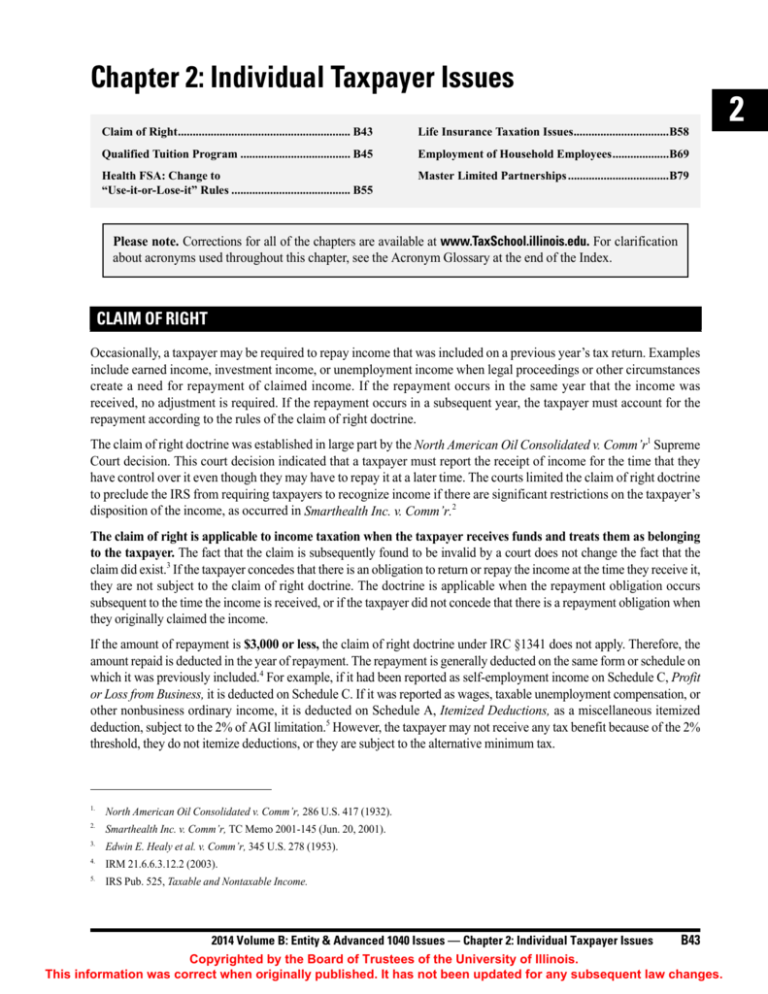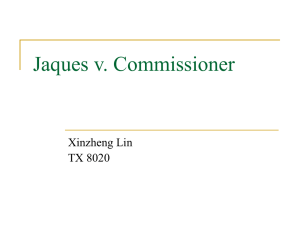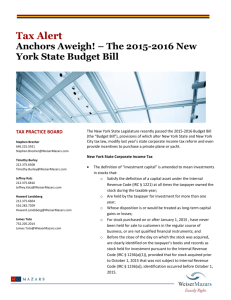Chapter 2: Individual Taxpayer Issues
advertisement

Chapter 2: Individual Taxpayer Issues Claim of Right.......................................................... B43 Life Insurance Taxation Issues................................B58 Qualified Tuition Program ..................................... B45 Employment of Household Employees...................B69 Health FSA: Change to “Use-it-or-Lose-it” Rules ........................................ B55 Master Limited Partnerships ..................................B79 Please note. Corrections for all of the chapters are available at www.TaxSchool.illinois.edu. For clarification about acronyms used throughout this chapter, see the Acronym Glossary at the end of the Index. CLAIM OF RIGHT Occasionally, a taxpayer may be required to repay income that was included on a previous year’s tax return. Examples include earned income, investment income, or unemployment income when legal proceedings or other circumstances create a need for repayment of claimed income. If the repayment occurs in the same year that the income was received, no adjustment is required. If the repayment occurs in a subsequent year, the taxpayer must account for the repayment according to the rules of the claim of right doctrine. The claim of right doctrine was established in large part by the North American Oil Consolidated v. Comm’r1 Supreme Court decision. This court decision indicated that a taxpayer must report the receipt of income for the time that they have control over it even though they may have to repay it at a later time. The courts limited the claim of right doctrine to preclude the IRS from requiring taxpayers to recognize income if there are significant restrictions on the taxpayer’s disposition of the income, as occurred in Smarthealth Inc. v. Comm’r.2 The claim of right is applicable to income taxation when the taxpayer receives funds and treats them as belonging to the taxpayer. The fact that the claim is subsequently found to be invalid by a court does not change the fact that the claim did exist.3 If the taxpayer concedes that there is an obligation to return or repay the income at the time they receive it, they are not subject to the claim of right doctrine. The doctrine is applicable when the repayment obligation occurs subsequent to the time the income is received, or if the taxpayer did not concede that there is a repayment obligation when they originally claimed the income. If the amount of repayment is $3,000 or less, the claim of right doctrine under IRC §1341 does not apply. Therefore, the amount repaid is deducted in the year of repayment. The repayment is generally deducted on the same form or schedule on which it was previously included.4 For example, if it had been reported as self-employment income on Schedule C, Profit or Loss from Business, it is deducted on Schedule C. If it was reported as wages, taxable unemployment compensation, or other nonbusiness ordinary income, it is deducted on Schedule A, Itemized Deductions, as a miscellaneous itemized deduction, subject to the 2% of AGI limitation.5 However, the taxpayer may not receive any tax benefit because of the 2% threshold, they do not itemize deductions, or they are subject to the alternative minimum tax. 1. North American Oil Consolidated v. Comm’r, 286 U.S. 417 (1932). 2. Smarthealth Inc. v. Comm’r, TC Memo 2001-145 (Jun. 20, 2001). 3. Edwin E. Healy et al. v. Comm’r, 345 U.S. 278 (1953). 4. IRM 21.6.6.3.12.2 (2003). 5. IRS Pub. 525, Taxable and Nontaxable Income. 2014 Volume B: Entity & Advanced 1040 Issues — Chapter 2: Individual Taxpayer Issues B43 Copyrighted by the Board of Trustees of the University of Illinois. This information was correct when originally published. It has not been updated for any subsequent law changes. 2 If the amount of the repayment exceeds $3,000, the taxpayer has two options available and can use the option that results in the lowest tax.6 Method 1. The taxpayer can compute the tax claiming a deduction for the repaid amount. Method 2. The taxpayer can claim a credit for the repaid amount. The following steps must be followed. 1. Compute the tax for the current tax year without deducting the repaid amount. 2. Recalculate the tax from the earlier year without including in income the amount that the taxpayer repaid in the current tax year. 3. Subtract the tax in item 2 from the tax shown on the taxpayer’s return for the earlier year. This is the amount of the credit. 4. Subtract the result in step 3 from the tax for the current tax year calculated without the deduction. If the tax calculated in method 1 is lower, the repayment is generally deducted on the same form or schedule on which it was previously included. If the amount must be deducted as a miscellaneous itemized deduction, it is entered on line 28 and is not subject to the 2% of AGI limitation. If the tax calculated in method 2 is lower, the credit is reported on Form 1040, line 71 (2013), or line 73 (2014). “Sec. 1341” should be entered next to the applicable line. If the taxpayer uses the cash method of accounting, they can take the deduction (or credit) for the tax year in which they actually make the repayment. If the taxpayer uses the accrual method, they are entitled to the deduction or credit in the tax year in which the repayment obligation accrues.7 These repayment rules do not apply to the following.8 • Deductions for sales to customers, such as returns and allowances • Deductions for theft losses due to fraud or embezzlement • Deductions for legal fees that are a result of contesting the repayment of income • Deductions for bad debts Example 1. Jackson is a self-employed writer. For 2012, he had taxable income of $74,000. Included in his gross income for the year was $40,000 of royalties that he reported on Schedule C. After being accused of plagiarism, Jackson returned $30,000 of the royalties in 2013. His taxable income for 2013 before taking the $30,000 repayment into account was $50,000. His filing status for both tax years is single. Jackson’s income and tax for both 2012 and 2013 are as follows. 2012 Taxable income Tax 2013 With Returned Income Without Returned Income Without Deduction With Deduction $74,000 19,875 $44,000 9,638 $50,000 12,113 $20,000 3,684 Under method 1, Jackson’s tax is $3,684. 6. Ibid. 7. Ibid. 8. Ibid. B44 2014 Volume B: Entity & Advanced 1040 Issues — Chapter 2: Individual Taxpayer Issues Copyrighted by the Board of Trustees of the University of Illinois. This information was correct when originally published. It has not been updated for any subsequent law changes. Under method 2, his tax is calculated as follows. Tax for 2013 without deducting the repaid amount Tax originally shown on 2012 return Tax for 2012 without including the amount of income repaid in 2013 Amount of credit Tax for 2013 after deducting credit $12,113 $19,875 (9,638) $10,237 (10,237) $ 1,876 Jackson’s tax under method 2 is $1,876. Because this amount is less than the tax calculated using method 1, he should take a credit for the repayment in 2013. He does this by reporting the $10,237 credit on line 71 of his 2013 Form 1040 as shown below. QUALIFIED TUITION PROGRAM As the cost of college tuition continues to increase, more parents and grandparents are contributing to qualified tuition programs. A qualified tuition program (QTP) is a program established and maintained by either a state government or an eligible educational institution. Contributions or payments to a QTP are not deductible; however, any distributions and earnings are tax-free if distributions do not exceed the designated beneficiary’s qualified education expenses. IRC §529 grants special tax status to QTPs. Accordingly, these programs are also called “section 529 plans” and must meet certain requirements. Amounts contributed to a QTP must be held in a qualified trust, and the plan must receive a ruling or determination from the IRS that indicates the program satisfies the applicable requirements. There are several requirements that must be met in order to be considered a QTP. • Contributions to the plan must be made in cash.9 (“Cash” includes checks, money orders, credit cards, or electronic transfers from banks or investment accounts.) • The plan must provide separate accounting for each designated beneficiary.10 • Neither the account owner nor the beneficiary is allowed to direct the investment of the account.11 However, account owners are permitted to choose between broad-based investment strategies and to change investment strategies only once per year. • The QTP plan cannot be pledged or used as security for a loan.12 • The plan must have adequate safeguards in place to prevent contributions greater than the amount reasonably expected to be necessary for the beneficiary’s higher education expenses.13 Unlike other education tax benefits, there are no income limitations with QTP accounts. 9. IRC §529(b)(2). 10. IRC §529(b)(3). 11. IRC §529(b)(4). 12. IRC §529(b)(5). 13. IRC §529(b)(6); Prop. Treas. Reg. §1.529-2(i)(1). 2014 Volume B: Entity & Advanced 1040 Issues — Chapter 2: Individual Taxpayer Issues B45 Copyrighted by the Board of Trustees of the University of Illinois. This information was correct when originally published. It has not been updated for any subsequent law changes. 2






